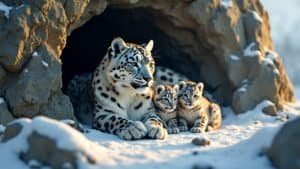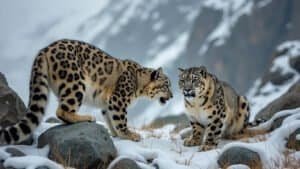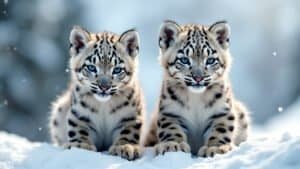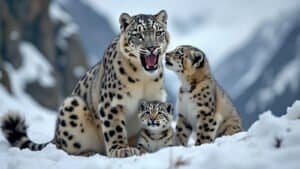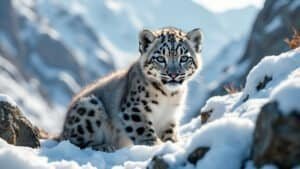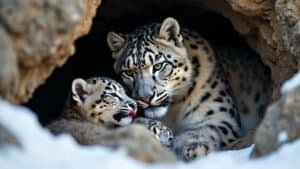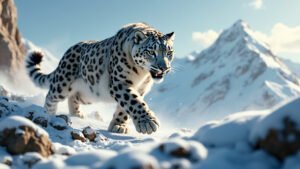Introduction
Snow leopards, known for their elusive nature and majestic presence in the high-altitude mountains of Central and South Asia, play a crucial role in maintaining the balance of their ecosystem. A vital part of their survival strategy involves teaching their young how to hunt
This article delves into the fascinating process by which snow leopard mothers train their cubs, exploring the age at which cubs start learning, the specific techniques used by mothers, and how these skills progress over time
Additionally, we’ll examine the impact of environmental factors on these hunting lessons and how they prepare the cubs for an independent life in the wild
At What Age Do Snow Leopard Cubs Start Learning to Hunt?
Snow leopard cubs begin their journey into the world of hunting at a relatively young age. Born in the seclusion of rocky dens, these cubs spend their early weeks completely dependent on their mother for nourishment and protection
As they grow, their mother gradually introduces them to the harsh realities of their environment, including the essential skill of hunting
Early Development Stages
Snow leopard cubs are born blind and helpless, weighing just about 1 pound (450 grams). For the first few weeks, their primary focus is on growing and gaining strength under the careful watch of their mother
Their eyes typically open around 7 to 9 days after birth, and by the time they reach one month old, they start to venture out of the den under the guidance of their mother. It is during this period, generally between 2 to 4 months of age, that the cubs are introduced to solid food, often the remains of their mother’s kill
First Hunting Lessons
The first lessons in hunting typically begin when the cubs are around 3 to 4 months old. At this stage, the mother starts taking them on short excursions away from the den, allowing them to observe her hunting behaviors
These early outings are crucial, as they provide the cubs with an opportunity to learn by watching and imitating their mother. The cubs start by engaging in play that mimics hunting, such as stalking, pouncing, and wrestling with each other
This play behavior is more than just fun—it’s a critical part of their learning process, helping to develop the skills they will need to hunt for real
Importance of Timing in Hunting Education
Timing is everything when it comes to teaching snow leopard cubs how to hunt. The mother must balance the cubs’ need for protection with the necessity of teaching them survival skills
Introducing hunting too early could expose the cubs to unnecessary danger, while starting too late could leave them unprepared for the challenges they will face when they eventually become independent
Research suggests that the most effective hunting education occurs between 6 to 12 months of age, during which cubs begin to take more active roles in the hunt, moving from mere observers to participants. By this time, the cubs have developed enough strength and coordination to attempt catching prey, though success rates are initially low
Scientific studies have noted that the survival rate of snow leopard cubs is closely tied to the effectiveness of these early hunting lessons. Cubs that do not acquire sufficient hunting skills by the time they reach 18 to 24 months—the age at which they typically leave their mother—are less likely to survive on their own
Therefore, the mother’s role in ensuring her cubs are well-trained in hunting is critical not only for their immediate survival but also for the long-term viability of the species
Techniques Snow Leopard Mothers Use to Teach Hunting
Snow leopard mothers employ a range of techniques to teach their cubs the vital skill of hunting. These techniques are carefully timed and adapted to the cubs’ developmental stages, ensuring that they learn at a pace that balances safety and skill acquisition
The process is a complex blend of imitation, play, and hands-on practice, all aimed at preparing the cubs for a life of self-sufficiency in the wild
Imitation and Play as Learning Tools
One of the primary methods by which snow leopard cubs learn to hunt is through imitation. From a young age, cubs closely observe their mother as she hunts, studying her movements, techniques, and strategies
This observational learning is crucial, as it allows the cubs to understand the fundamentals of stalking prey, positioning for a pounce, and making a successful kill. The mother often allows her cubs to watch from a safe distance during these hunts, gradually introducing them to the experience without direct involvement initially
Play behavior is another critical component of the cubs’ education. Cubs engage in mock hunting games, where they practice stalking and pouncing on each other or on objects in their environment
This play is not merely recreational; it serves as an essential training ground where cubs refine their coordination, strength, and timing. Studies have shown that play among snow leopard cubs closely mimics the behaviors they will need to employ during actual hunts, making it a fundamental aspect of their learning process
Gradual Introduction to Hunting
As the cubs grow and their skills improve, the mother begins to involve them more directly in the hunting process. Initially, this might involve allowing the cubs to approach prey that has already been killed, giving them a chance to experience the sensation of capturing and consuming their food
Over time, the mother increases the difficulty of the tasks, encouraging the cubs to participate in stalking and chasing live prey
This gradual introduction is key to ensuring the cubs do not become overwhelmed or frightened. The mother may choose smaller or slower prey for the cubs’ first hunting attempts, such as young ibex or hares, which are easier to catch than the larger and more agile prey that adult snow leopards typically hunt
By setting the cubs up for success in these early hunts, the mother builds their confidence and hones their hunting instincts
Fine-Tuning Hunting Skills
As the cubs approach the age of independence, their mother’s role shifts from teacher to facilitator, fine-tuning the skills the cubs have developed
During this phase, the mother might lead her cubs to more challenging hunting grounds or more difficult prey, requiring them to use all the skills they have learned
She might also deliberately leave the cubs to hunt alone, watching from a distance and only intervening if necessary. This allows the cubs to experience the full cycle of the hunt, from stalking to killing to eating, reinforcing the techniques they have learned
The mother also teaches her cubs how to navigate the mountainous terrain that is characteristic of snow leopard habitats. This includes guiding them through steep, rocky slopes and across icy surfaces, all while remaining silent and undetected by prey
These lessons in stealth and endurance are as important as the act of hunting itself, as they ensure the cubs can survive in the challenging environments they will one day navigate on their own
Scientific research into the behavior of snow leopards has highlighted the importance of this fine-tuning phase. Cubs that undergo thorough training in varied hunting conditions are more likely to thrive when they eventually become independent
Studies suggest that cubs with extensive hunting practice are better equipped to handle the physical demands of catching prey and have higher survival rates in the wild
Progression of Snow Leopard Cubs’ Hunting Skills
As snow leopard cubs grow, their hunting skills develop in stages, gradually progressing from playful mimicry to actual predation. This progression is crucial for their survival, as it determines how well they can fend for themselves once they leave their mother
The development of these skills is a testament to the effectiveness of the mother’s teaching methods and the cubs’ innate abilities
Initial Attempts and Challenges
In the early stages of learning, snow leopard cubs face numerous challenges as they begin to transition from observing to participating in hunts. Their first attempts are often clumsy and unsuccessful, marked by a lack of coordination and timing
These initial failures, however, are an essential part of the learning process. The mother snow leopard is patient during these early attempts, understanding that practice is necessary for her cubs to improve
She continues to bring back small prey for the cubs to practice on, gradually encouraging them to make their own attempts at hunting live animals
During this phase, the cubs often struggle with the physical demands of hunting in their mountainous habitat. The steep, rugged terrain can be particularly challenging for young cubs, who are still developing the strength and agility needed to navigate it effectively
Despite these challenges, the cubs’ persistence is key, as each attempt helps to build the muscle memory and experience they will need to become proficient hunters
Signs of Proficiency in Hunting
As the cubs reach the age of 8 to 12 months, their hunting skills begin to show marked improvement. At this stage, they start to exhibit more refined techniques, such as better timing in their pounces and improved stealth when stalking prey
They also become more involved in the actual kill, rather than merely observing or assisting. Successful hunts become more frequent, though the mother still plays a significant role in ensuring that her cubs are fed and protected
By this time, the cubs have also become more adept at navigating their environment. They learn to use the terrain to their advantage, such as by ambushing prey from above or using rocks and crevices for cover
Their ability to anticipate the movements of prey and to adjust their strategies accordingly is a key indicator of their growing proficiency. Research on wild snow leopards has shown that cubs who reach this level of skill are much more likely to survive the critical period after they become independent
Transition to Independent Hunting
The final stage in the progression of a snow leopard cub’s hunting skills occurs as they approach 18 to 24 months of age. At this point, the cubs are on the cusp of independence and must be able to hunt successfully on their own
The mother gradually reduces her involvement, forcing the cubs to rely more on their own abilities. This period is crucial, as it tests the cubs’ readiness to survive without maternal support
Cubs at this stage are typically capable of taking down small to medium-sized prey on their own, though they may still struggle with larger animals
Their hunting strategies have become more sophisticated, incorporating lessons learned from past experiences. This includes knowing when to conserve energy and when to pursue prey, as well as how to use their environment most effectively during a hunt
Studies of snow leopard populations have indicated that the success of this transition to independence is a strong predictor of a cub’s long-term survival. Cubs that are well-prepared and have had ample practice are more likely to establish their own territories and thrive as solitary adults
On the other hand, cubs that struggle during this transition may face difficulties in securing enough food, which can lead to malnutrition and decreased survival rates
Environmental Factors Influencing Hunting Lessons
The harsh and variable environments in which snow leopards live play a significant role in shaping how mothers teach their cubs to hunt. The challenges posed by the terrain, climate, and availability of prey all influence the strategies and timing of hunting lessons
Understanding these environmental factors is crucial to appreciating the complexities involved in raising successful hunters in the wild
Terrain Challenges and Adaptations
Snow leopards inhabit some of the most rugged and inaccessible terrains in the world, including the steep mountains of Central and South Asia. These environments present a unique set of challenges for both the mother and her cubs
The rocky, uneven ground requires the cubs to develop exceptional agility and balance from an early age. As they accompany their mother on hunting expeditions, they must learn to navigate these obstacles while remaining stealthy and undetected by prey
The terrain also influences the types of hunting techniques that are most effective. For instance, snow leopards often use the element of surprise by ambushing prey from above, taking advantage of the steep slopes and cliffs
Cubs must learn to position themselves strategically in these environments, which requires not only physical skill but also an understanding of the landscape. The mother leopard’s role in teaching her cubs how to use the terrain to their advantage is critical for their future success as hunters
Seasonal Impacts on Hunting Training
The changing seasons in snow leopard habitats add another layer of complexity to hunting lessons. During the winter months, when snow covers the ground, the mother must adapt her hunting strategies to the conditions
Prey may become more difficult to find, and the deep snow can hinder the cubs’ movements, making it harder for them to keep up with their mother during hunts
However, the snow also provides an opportunity for the cubs to learn important skills. For example, they must master the art of moving silently across the snow without alerting prey
The mother may use this time to teach her cubs how to track animals through the snow, identifying signs of their presence such as tracks or scat. These lessons are crucial, as they equip the cubs with the skills needed to hunt effectively in different conditions
In the summer, when prey is more abundant, the mother can focus on refining her cubs’ hunting techniques. The increased availability of food allows for more frequent hunting opportunities, giving the cubs ample practice
The varied conditions across seasons ensure that the cubs are well-rounded in their hunting abilities, capable of adapting to whatever challenges they may face as adults
Prey Availability and Hunting Opportunities
The type and availability of prey in a given area also significantly influence the hunting lessons that snow leopard cubs receive
Snow leopards primarily hunt ungulates such as blue sheep, ibex, and argali, but they will also prey on smaller animals like marmots and hares when larger prey is scarce. The abundance or scarcity of these animals can dictate the frequency and nature of hunting practice that the cubs experience
In areas where prey is plentiful, the mother can afford to take more risks in her teaching, allowing the cubs to engage in hunting even if they are not yet fully skilled. This abundance provides the cubs with multiple opportunities to practice and refine their techniques
On the other hand, in areas where prey is scarce, the mother must be more cautious, ensuring that each hunt has a higher chance of success. This situation may limit the cubs’ hands-on experience, but it also teaches them the importance of patience and precision in their hunting strategy
Additionally, the types of prey available can affect the specific techniques that the cubs learn. For example, hunting larger ungulates requires different strategies compared to smaller, more agile prey
The mother adapts her teaching to the prey available, ensuring that her cubs develop a diverse set of skills that will serve them in various hunting scenarios throughout their lives
Research has shown that snow leopard cubs raised in areas with diverse prey populations tend to have better hunting success as adults
This variety during their learning phase equips them with a broader range of techniques and the ability to adapt to changing conditions in their environment, which is essential for survival in the unpredictable and often harsh climates they inhabit
Conclusion
Snow leopard mothers play a crucial role in their cubs’ survival by teaching them the essential skill of hunting. From their earliest days, cubs learn through observation, play, and gradual participation in hunts, guided by their mother’s expertise
These lessons are carefully timed and adapted to the cubs’ developmental stages, ensuring they are ready to hunt independently by the time they leave their mother
The progression of hunting skills is influenced by various factors, including the rugged terrain of their mountainous habitat, seasonal changes, and the availability of prey
Each of these environmental challenges contributes to the cubs’ learning, equipping them with the knowledge and experience necessary to thrive in the wild. The effectiveness of these early lessons determines not only the cubs’ immediate survival but also their long-term success as solitary hunters
As we explore the intricate process of how snow leopard mothers teach their cubs to hunt, it becomes clear that these lessons are about more than just catching prey—they are about ensuring the continuation of a species that is both majestic and vulnerable, dependent on the careful balance of nature and the knowledge passed from one generation to the next


